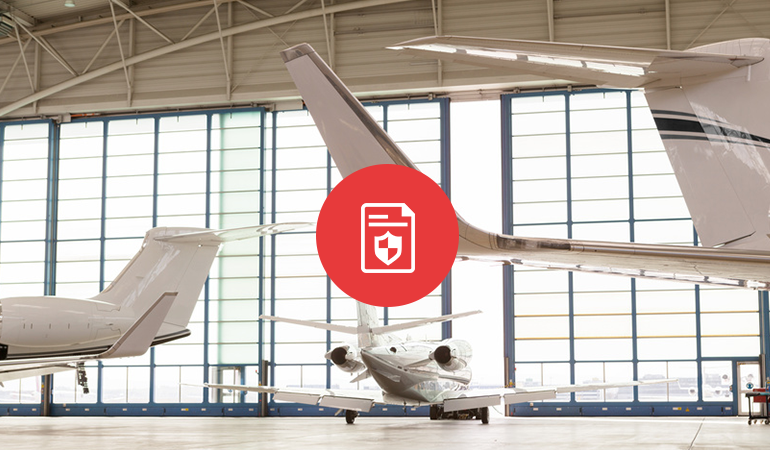Aircraft hangar insurance is not a topic that usually clogs up web browser tabs, or climbs the ranks of Google search metrics. In light of recent natural disasters like hurricane Harvey and Irma, aircraft owners and operators should be cognizant to bring this back to the forefront of their minds. Aircraft insurance is fairly common knowledge and common sense, but what about its roost? Hangars often house tens of thousands of dollars’ worth of tools, spare parts, and ground service equipment (GSE) yet insuring this asset is largely overshadowed by insuring the aircraft itself. It is time to turn a spotlight on what you need to know about aircraft hangar insurance.
Why is aircraft hangar insurance important?
There are some fairly obvious reasons why aircraft hangar insurance is important in addition to aircraft insurance. Aircraft insurance is primarily designed to protect the aircraft during operational usage, as well as covering individual components of aircraft which are extremely costly. For instance, turbine engines should have their own coverage amounts specified since their replacement cost alone is so high. Again, aircraft insurance is primarily geared toward the aircraft in operation. When an aircraft is static in a hangar, the aircraft insurance coverage tapers off which is where good hangar insurance becomes a necessity.
Aircraft insurance generally ends when an aircraft is not in motion. Most aircraft, aside airliners and some charters, spend the vast majority of their life in the hangar. Hangars, being a man-made shelter, are susceptible to natural disasters such as wind, water, and fire. Hangars also are essentially industrial facilities since they house machines and their various sundry of tools, fluids, and parts. Hangar insurance is the medium which protects the aircraft hull, along with protecting the tools and ground support equipment.
Hangar insurance is not just a protection against disasters. It is the instrument which offers liability protection for hangar owners against suit in the event of damage. What this means to fixed base operators (FBOs) and renters who lease hangar space for profit is that they are afforded protection from civil lawsuit by renters whose aircraft and associated equipment is damaged.
Different types of hangar insurance
The common notion would categorize hangar insurance as a one-size-fits-all commodity, but this is not necessarily true. The distinction in types of hangar insurance boils down to whether the insured is a private owner of aircraft and hangar, an aircraft owner who rents space, or an owner of the hangar(s) being rented.
Hangar insurance for private owners of both hangars and aircraft
The private owner of hangar and aircraft is compelled to buy owner’s insurance for the aircraft, as well as owner’s insurance for the structure and all equipment within. Were the property to be destroyed, the owner has a vested interest in ensuring all of the property is fully replaced.
Hangar insurance for private owners of aircraft
The private aircraft owner who rents hangar space can become left in a lurch in the event that their aircraft is damaged or destroyed due to conditions outside of their control while residing in rented hangar space. Aircraft insurance, as prior stated, is intended to protect the aircraft during operation, and certainly has no provisions for the replacement of lost tools, supplies, and parts which may be destroyed.
Hangar insurance for hangar owners
For the owner of leased property, dedicated hangar insurance offers business property protection, liability protection, automobile liability insurance, and pollution insurance. It is important to dissect each of these critical components to fully understand the protection afforded to the owner. Business property protection is the tool which provides assurance that the assets which make your business move, such as aircraft tugs and GSE, tools, parts and supplies are replaced after damage. If the business also owns and stores aircraft in addition to leasing hangar space, ground risk hull coverage may be added. General liability protection provides the peace of mind that owners are covered in the event that a third party is injured in their facility, or a third party’s aircraft and equipment are damaged or destroyed. Many FBOs provide “courtesy cars” or have a shuttle service, so automotive liability insurance is available as an add-on to hangar insurance policies. Pollution insurance is made available since FBOs routinely deal with fuel and many chemicals. This component of the policy ensures that the organization can pay for containment and clean-up, as well as the ensuing litigation from environmental agencies.
While there are a number of different vendors of insurance policies, as a generality they all are members of the National Hangar Insurance Program (NHIP). NHIP is essentially an organization which standardized hangar insurance and sought to form a partnership with a reputable insurance company with a global presence, which was Travelers. Until NHIP organized this relatively obscure, niche segment of the market, there was no apparent order and organization to insuring an owner’s hangar. Traditional forms of property and renters insurance did not quite fit the bill due to the inherently sensitive nature of aircraft, as well as the operational vice static nature of aircraft.
What are the potential pitfalls of buying aircraft hangar insurance?
First and foremost, make sure that your aircraft hangar insurance policy is provided by a broker who is a member of NHIP. Your friendly business agent who sells standard policies to traditional brick-and-mortar business, including those in the transportation industry, will likely be more than happy to sell you a general liability policy and business property policy, but their underwriters will have little to no concept of aviation-specific needs, or the costs associated with aircraft items. They will likely value an aircraft tug along the lines of a generic warehouse tug or pallet mover, whereas the actual cost of aviation-specific support equipment may be many times that of general industrial machinery.
Also, consider costs of aircraft parts and components which are routinely stored in a multi-purpose hangar. Even a small turbine engine can cost over $100,000; piston aircraft engines are routinely valued from $20,000 to over $50,000, whereas a comparable industrial engine may only value for a third of that cost. Insurance underwriters who do not deal specifically in the arena of hangar insurance will undervalue the contents of the hangar because industrial equipment and components in other industrial disciplines.
Another potential problem to be aware of in hangar insurance is attempting to acquire it through your aircraft insurer. The assumption is that an aircraft insurance broker will have an understanding of hangar insurance is widely a misnomer. Aircraft insurance and hanger insurance are different entities, intended to serve different purposes. This is not to say that aircraft insurance agencies will not sell hangar insurance; however, should you choose to use an aircraft insurance agency to provide hangar insurance it would be in your best interest to ensure they are a member of a recognized order similar to or including the NHIP. This is the best way to be certain that your coverage is going to provide the necessary value in the event that property is damaged.
Where can you purchase hangar insurance?
Hangar insurance is available from a variety of agencies. Some of the agencies specialize strictly in this sort of airport property insurance, while others offer hangar insurance in conjunction with aircraft insurance. Hangar insurance is also offered through several of the major aviation advocacy organizations like the Aircraft Owners and Pilots Association (AOPA) and the Experimental Aircraft Association (EAA). As previously mentioned, perhaps the most important aspect of buying hangar insurance is not as much about who it is being purchased from, but about making sure that it follows the established guidelines of an organization like NHIP. That being said, there are some distinct advantages in using insurance from a very large entity such as the AOPA or the EAA. These organizations carry a lot of weight in the industry and have very deep pockets. You, the owner, can very reasonably expect full clout of these organizations to be behind your purchase. The downside to consider is that customer service may not be nearly as personal as dealing with a small, independent firm.
Other important things to know about hangar insurance
Geography is everything. Coverage and premiums are going to increase when you decide to hangar in areas prone to significant storm damage, such as the eastern seaboard of the United States. This is not any sort of hidden fine-print; most of the companies researched state this in their FAQ sections. The evidence has presented itself in the past few weeks of exactly why this is the case, with enormous damage left in the wake of hurricanes Harvey and Irma.
It is fairly common practice that aircraft owners store recreational items in their hangars such as boats, golf carts, all-terrain vehicles, and even sports cars. These are not going to fall under the umbrella of hangar insurance. This does not mean that you cannot continue to park such items in a hangar; they simply will not be covered by hangar insurance if damaged.
Hangar owners who rent space for profit may apply loss of revenue as an optional coverage to hangar insurance.
Conclusion to aircraft hangar insurance
Aircraft hangar insurance is something which most people keep neatly tucked out of sight and mind unless the times comes to call upon it. An aircraft is perhaps the most costly asset to own which receives the least use, and the protection of said asset is quite convoluted and confusing. Furthermore, the associated GSE to sustain aircraft operation are particular and expensive. Aircraft insurance covers just that: the aircraft, and generally only during operation. Hangar insurance is very important because many aircraft damage by natural disasters, fire, and theft during the periods of inactivity. Owners should take great care in thoroughly researching the right plan to insure all of the assets which make their aircraft fly, not just the aircraft itself.
Are you interested in ground handling and hangar management? Then our free eBook is just the right thing for you – get your copy now!



Comments